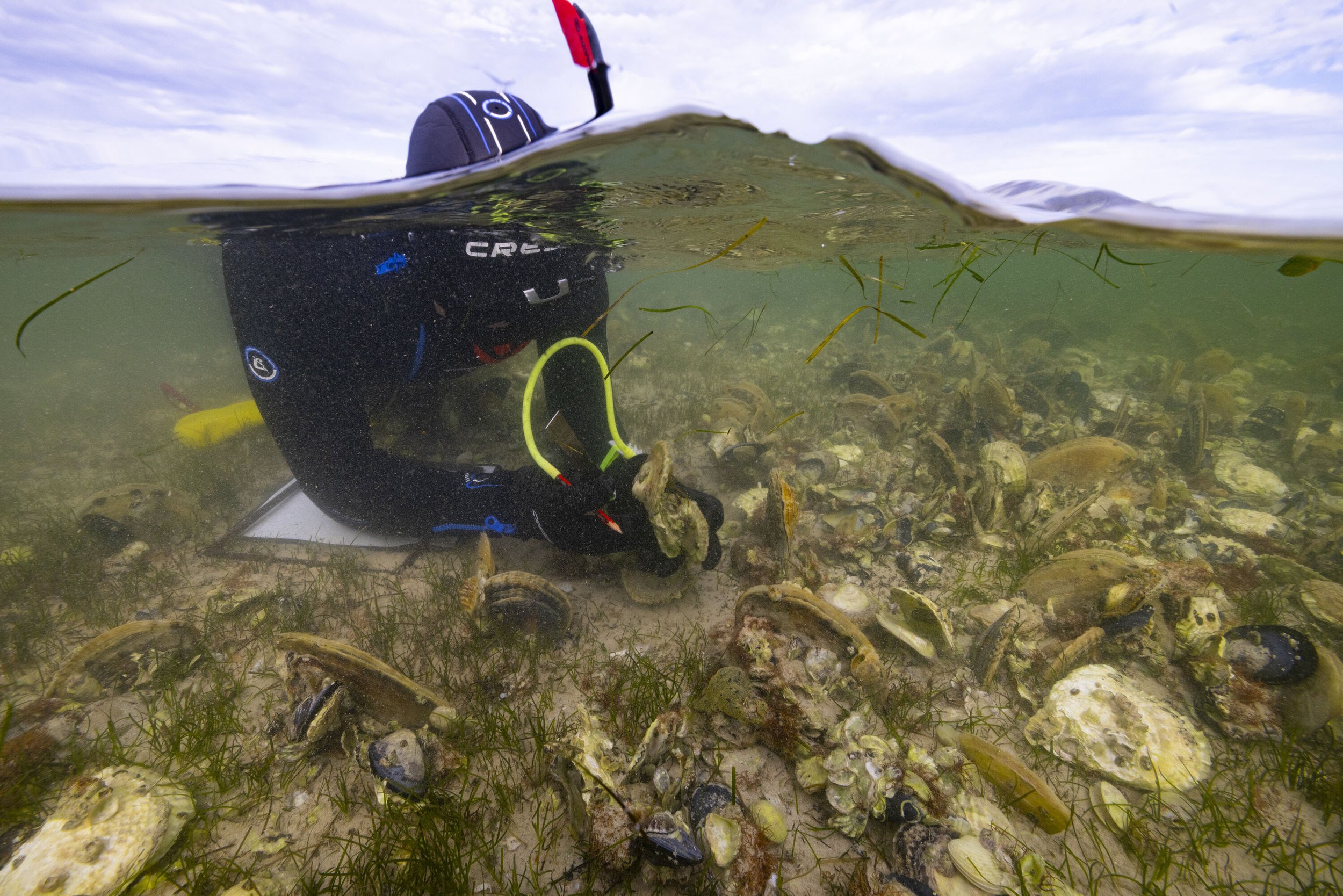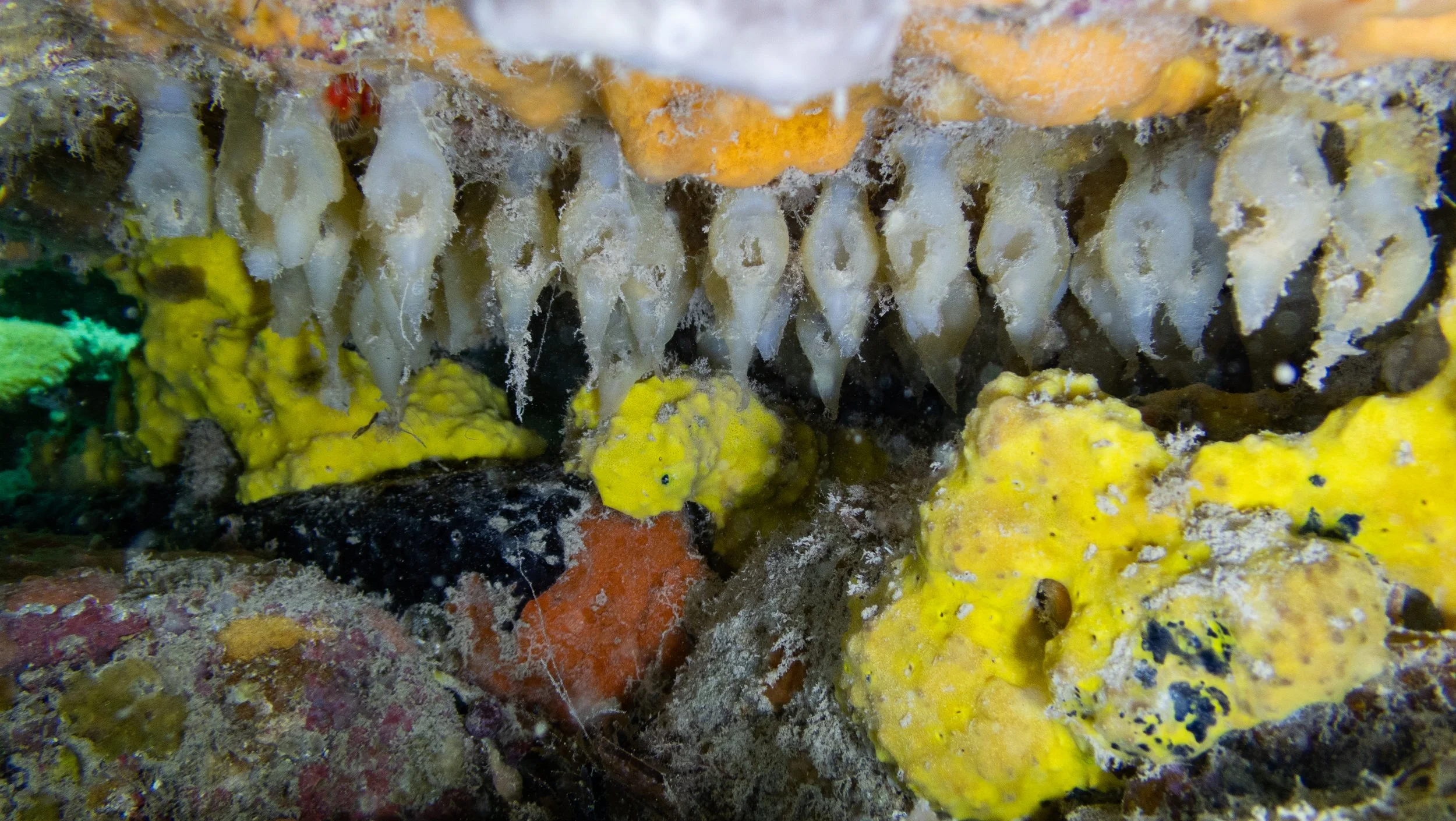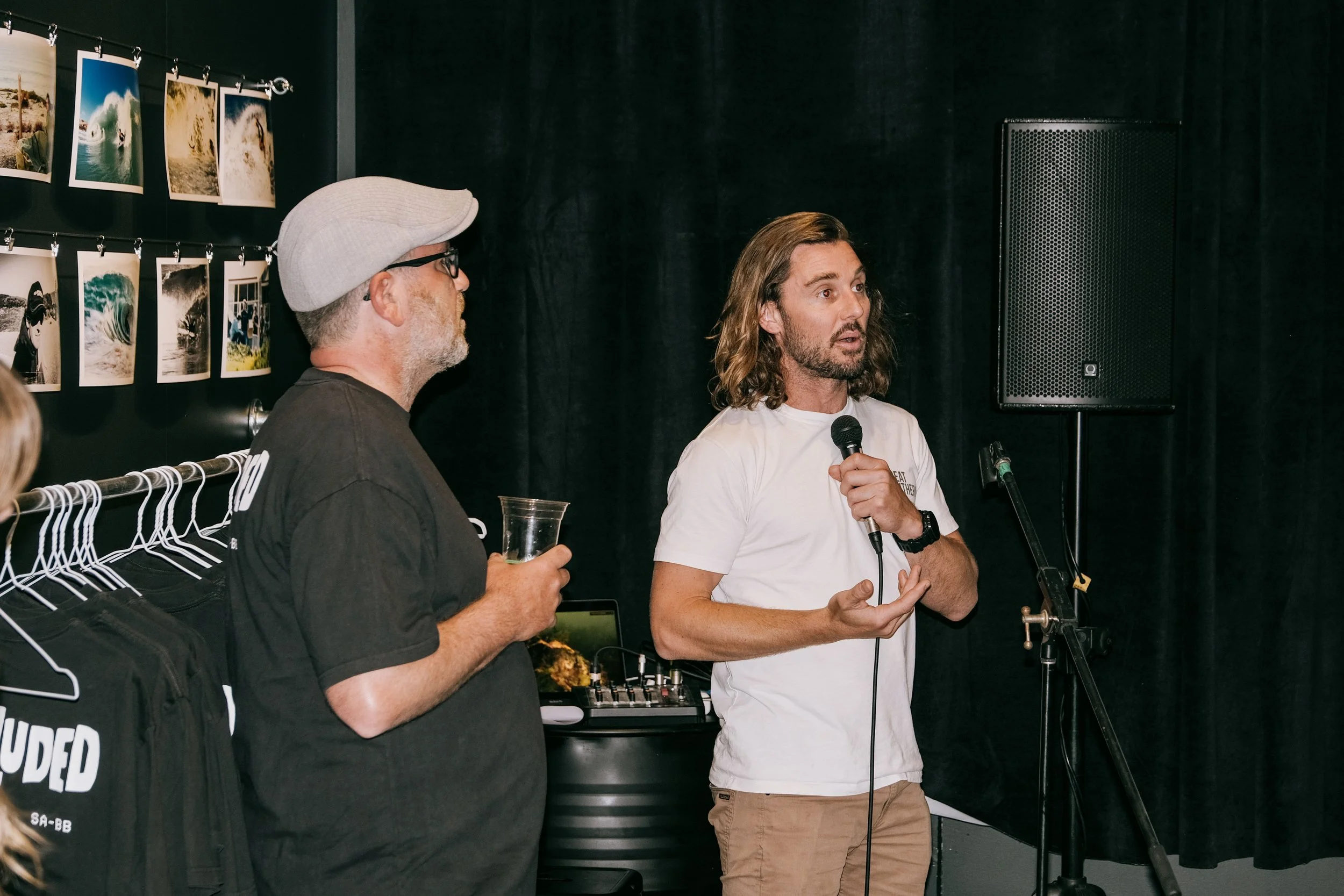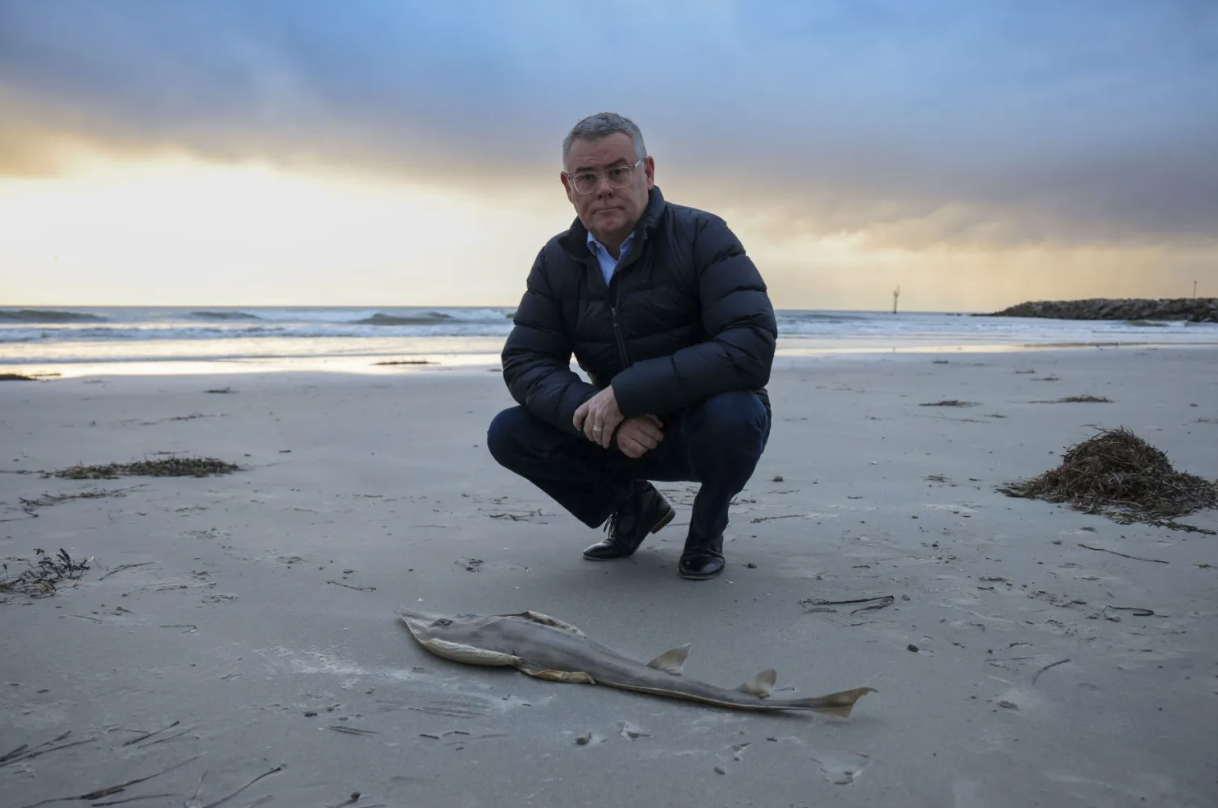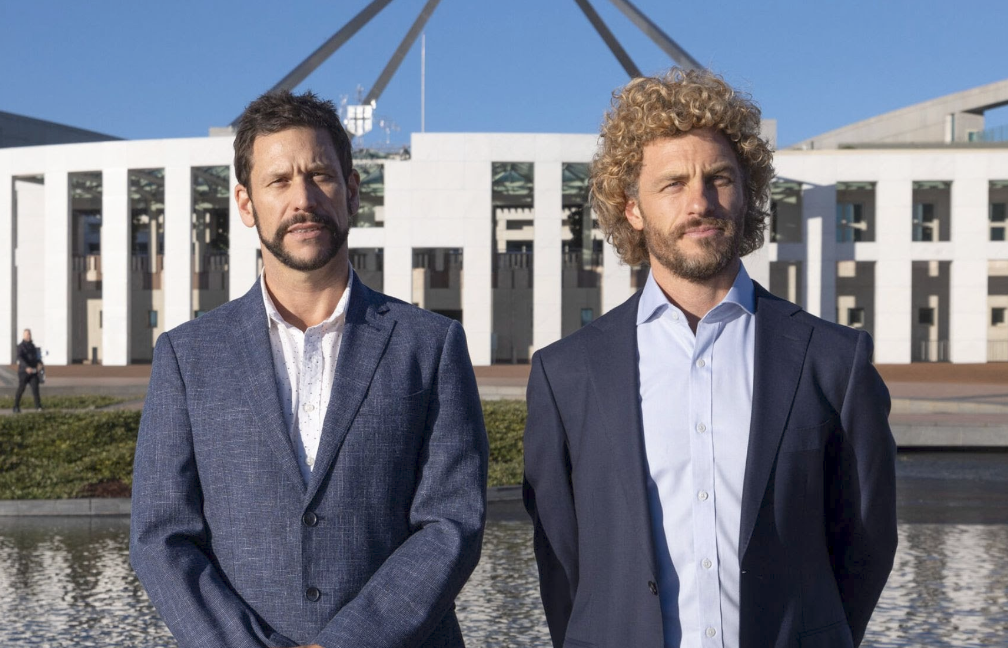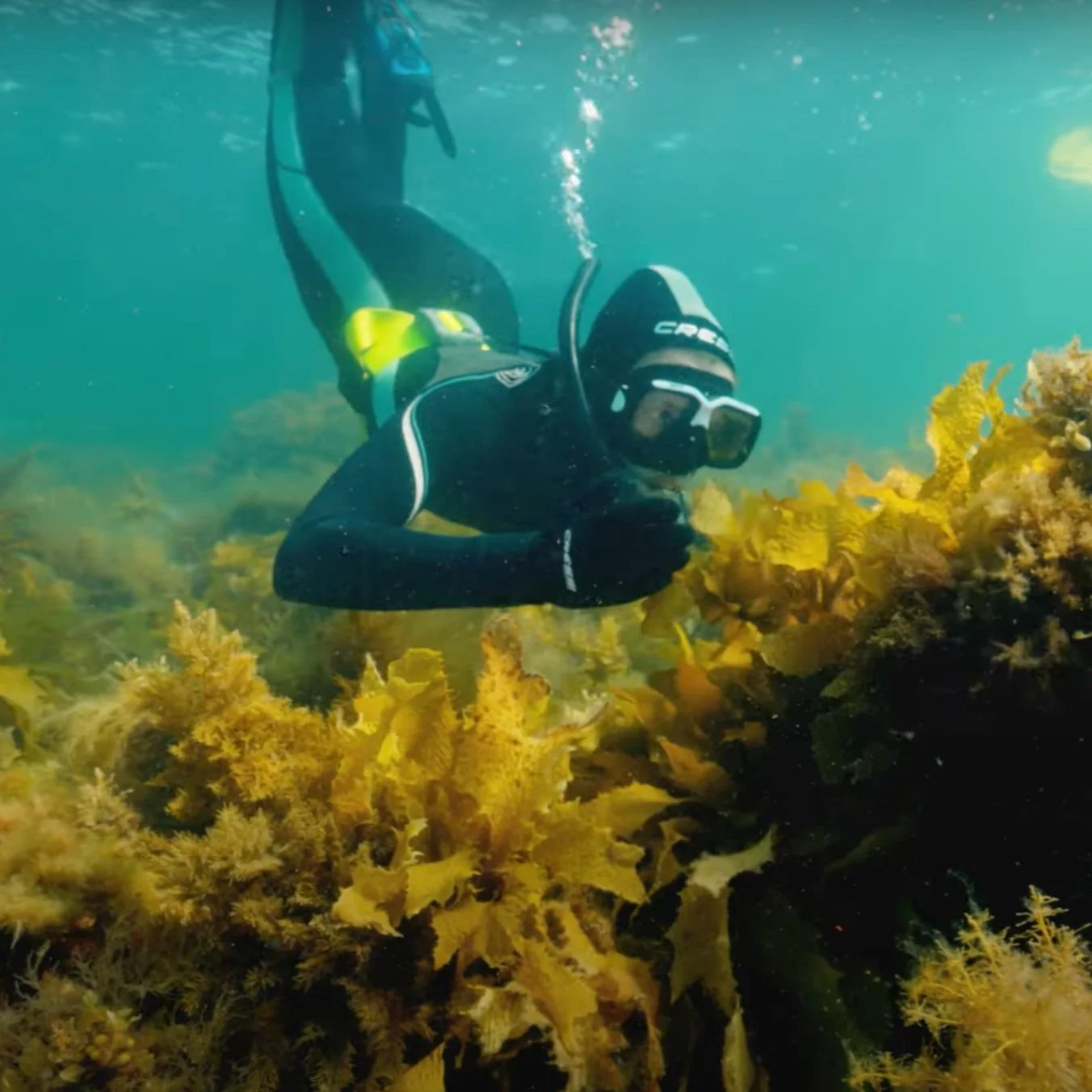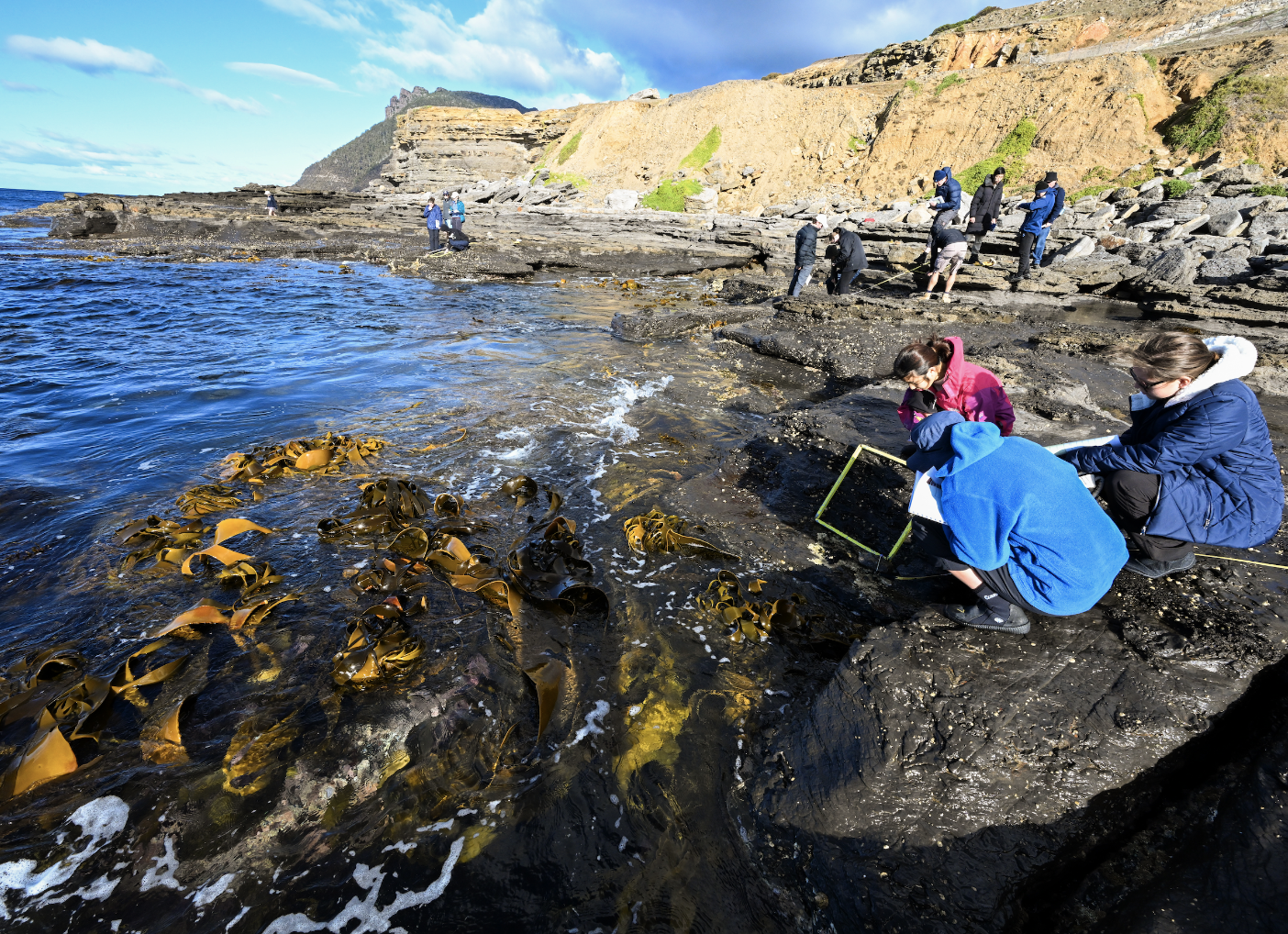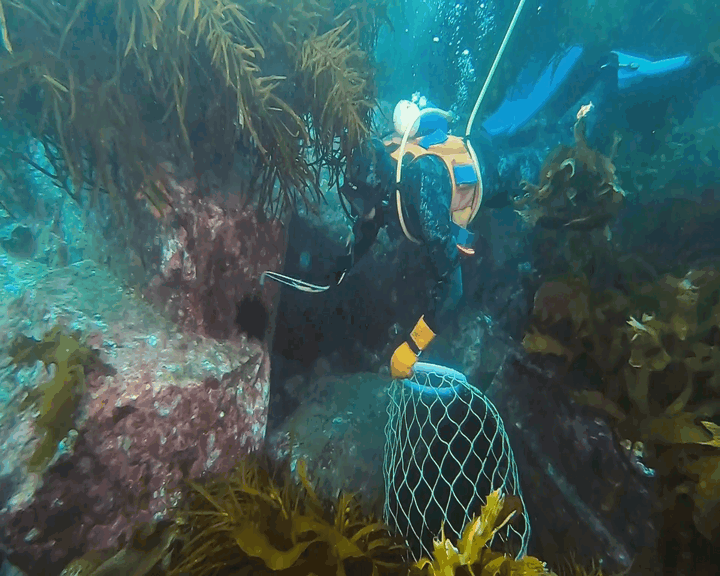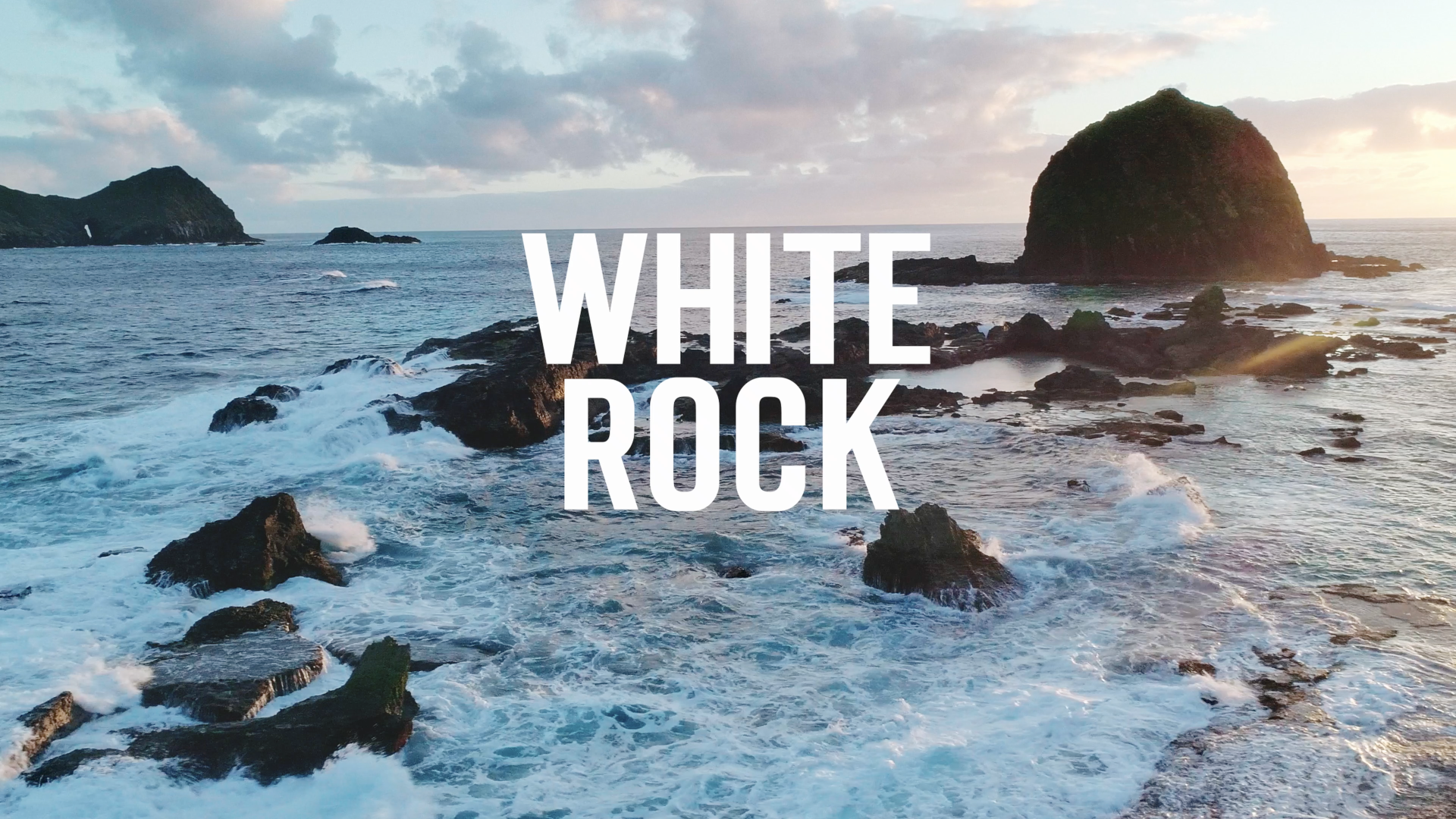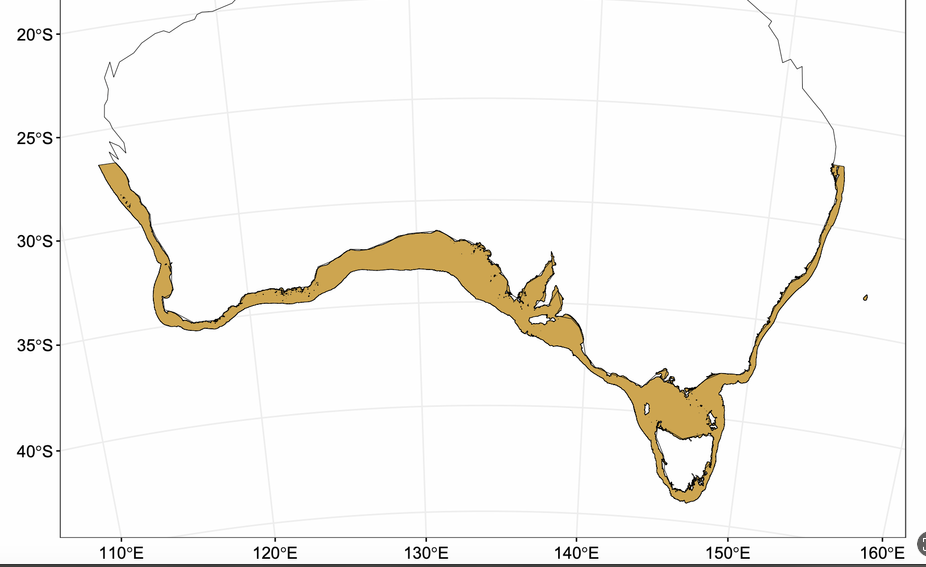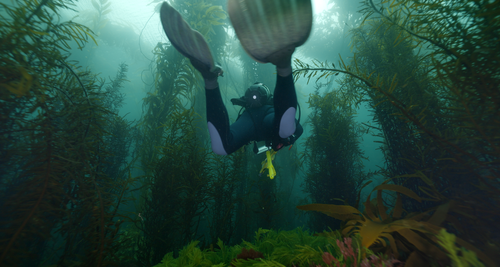
November 2025
Welcome to the November issue of the Great Southern Reef newsletter. This issue is packed with new stories of action and collaboration, from Sea Country leaders uniting in NSW Parliament, to restoration and research projects across southern Australia, plus exciting announcements for educators and partners.
Sea Country Leaders Unite
Aboriginal Sea Country leaders, scientists, and industry representatives gathered at NSW Parliament House for a special screening of White Rock. The event followed a historic meeting earlier in the day where Aboriginal Saltwater peoples from across New South Wales voted unanimously to form a new Aboriginal Sea Country Alliance.
The alliance unites coastal Nations to lead the response to the state’s declining reef systems. Image: Michael Power Their statement, read in Parliament before the screening, called on governments to recognise Aboriginal connections to Sea Country and to resource Aboriginal participation in reef restoration, marine management and self-determined livelihoods. It was the first time such a unified call had been made at state level, marking a shift from consultation to leadership.
Watch: A poetic statement by Walbanja woman Jodi Edwards, shared at the event.“We’ve identified the problem. We’ve built the plan. All that’s left is to get started.”
Reading the Reef, Tracking Change
As a Principal Research Scientist working at the intersection of research, policy and management, Dr. Nathan Knott brings almost three decades of experience to help us understand temperate marine systems. From long-term monitoring of marine protected areas to tracking the movement of fish and assessing a wide range of human impacts, his work helps inform decisions that shape the future of the Great Southern Reef.
But how did he get here? In this new feature article and video, we trace Nathan’s path from an early fascination with ecological processes to his work influencing management and conservation policy today. Along the way, we explore the challenges of balancing marine protection with industry, the power of collaboration through the Great Southern Reef Research Partnership, and why long-term monitoring is critical in a rapidly changing ocean.
White Rock Educator Masterclass
We are excited to announce the White Rock documentary will be available to schools throughout Australia via the ClickView platform for the 2026 school year. A comprehensive school resource kit will also launch alongside the film on the GSRF Educator Hub.
Teachers are invited to join our Educator Masterclass (Years 7–12) on the 22nd of January, to explore how White Rock can be integrated into the classroom. The session will walk you through the new curriculum-linked resource kit and offer an exclusive preview of a new urchin board game.
Building Hope From The Bottom Up
After months of devastation across South Australia’s coast, community-driven restoration efforts are underway to help rebuild coastal resilience. Marine ecologist Dr Dominic McAfee - Future Making Fellow at the University of Adelaide and member of the Great Southern Reef Research Partnership - says shellfish restoration has come a long way in the past decade.
McAfee’s Reviving Coffin Bay’s Lost Oyster Reefs project, recently recognised with an Australian Geographic Society award, is part of a growing network of community-led restoration initiatives stretching from Kangaroo Island to the Eyre Peninsula. Using biodegradable mesh bags filled with local shells, these structures provide habitat for baby oysters that grow into reefs capable of filtering millions of litres of seawater each day.
Biodegradable mesh bags filled with local shellsMcAfee recently co-authored a Science letter calling for a nationally coordinated response to marine heatwaves and harmful algal blooms across the Great Southern Reef. That same call for collaboration underpins the current shift toward restoration and long-term recovery.
“It’ll take years, but there’s proof this can work, and collaboration is the way forward.”
Community-based projects like these also generate valuable ecological data. By identifying suitable sites for recovery and monitoring how restored reefs perform, they’re helping shape the design and placement of larger-scale restoration programs.
Hatching Success at Cuttlefish Coast
Following a strong breeding season, Giant Australian cuttlefish have been hatching across the Cuttlefish Coast Sanctuary Zone in South Australia’s Upper Spencer Gulf Marine Park. To mitigate the risk posed by the harmful algal bloom, the State and Federal governments installed a bubble curtain to protect more than 50,000 eggs - a precaution that hasn’t needed to be activated.
Bubble Curtain in operation during weekly testing. Image: Stefan Andrews - DEW By now most eggs within the aggregation site will have hatched, marking a successful season for this remarkable species. The bubble curtain will remain available in the Upper Spencer Gulf for use in subsequent giant cuttlefish hatching seasons.
Hatched egg cases at the aggregation site. Image: Stefan Andrews - DEWBreakthrough in Algal Bloom Research
Through ongoing culturing and molecular genetic work by a team of researchers led by Professor Shauna Murray at the University of Technology Sydney (UTS), the little-known South African species Karenia cristata has been confirmed as a primary producer of brevetoxins in the 2025 South Australian algal bloom.
It appears to have been one of the dominant species throughout much of the event, previously reported only as Karenia sp, along with K. mikimotoi and other dinoflagellates in the publicly-available counts data. This important research on 5 harmful Karenia species and other relatives in the SA bloom mix was undertaken in record time by UTS, in collaboration with scientists from IMAS (University of Tasmania), Microalgal Services, the University of Queensland, SARDI, the Cawthron Institute, NSW DPIRD, and other collaborators.
Read our Spring Update by Janine Baker for the latest on impacts of the Karenia bloom, signs of resilience and recovery, community monitoring projects and new restoration trials.
This spring, it’s hoped that more of the remaining leafy seadragons will find each other and breed. Image: Marlene Boehm Young Forests Flourish Where Urchins Once Dominated
Following the dedicated harvest of over 25 tonnes of longspined sea urchins, juvenile golden kelp are starting to grow along shallow rocky reefs within Sydney Harbour. This rehabilitation work is part of Project Restore, a multi-habitat flagship project that aims to increase connectivity among habitats in Sydney Harbour.
Urchin removals at Camp Cove, Morella Reserve, Vaucluse Bay and Watsons Bay Baths were completed with commercial divers from South Coast Sea Urchins. The harvested urchins are repurposed as animal feed through Sydney Fish Market, contributing to a circular economy.
Diver removing Urchins and New Kelp Recruit “With hard work, future funding and science we hope to re-establish that lost kelp habitat.”
Early surveys now show kelp recruits at all four sites, signalling recovery after reduced grazing pressure. Monitoring will continue to track the growth of these new kelp forests and their role in restoring balance to Sydney’s underwater ecosystem.
Sea Urchin Herbivory Drives Reef Similarity
New research by IMAS scientists shows that urchin-affected reefs on Tasmania’s east coast now function much like those further north in New South Wales, with similar species and grazing patterns. The study, published in Marine Environmental Research, explored how climate-driven warming and sea urchin grazing are reshaping southern reef ecosystems.
The team compared kelp beds and urchin barrens at twenty reef sites across both states. Using underwater surveys and herbivory experiments, they tested whether community differences were greater between regions or between habitat types. They fixed small pieces of kelp and other algae either raised off the bottom for fish access only, or flat on the reef where both fish and urchins could graze.
The study found that the main factor shaping which species live on a reef (its structure) and how they interact through feeding and grazing (its functioning) was the type of habitat. Whether it was a healthy kelp bed or an urchin barren had a much stronger influence than where the reef was located.
Overall, the same habitat type on a different reef a thousand kilometres apart shared more similar species and grazing patterns than different habitat types on the same reef, 100s of meters apart.
The longspined sea urchin, Centrostephanus rodgersii, emerged as the main species driving these patterns. Where these urchins were abundant, kelp pieces fixed flat on the reef surface were eaten more, showing strong grazing pressure. In contrast, pieces suspended just above the bottom, accessible only to fish - were left mostly intact. This elegant experiment showed that most of the grazing and tropicalisation impacts on these reefs is driven by urchins rather than fish.
Undervaluing Australia’s Key Marine Habitats
Australia’s marine and coastal habitats deliver huge benefits, but we are still selling them short. A new review, undertaken by leading marine and coastal scientists in government and universities, reports that Australian studies often undervalue habitats like kelp, mangroves, and seagrass, especially for provisioning and cultural services. Lead author Dr Laura Montano from UNSW Sydney, warns that our current policies can reward damage and shortchange protection with Australian values well below global medians.
Kelp forests remain undervalued in national assessments, with Western and South Australia still major data blind spots.“Awareness drives care. But too often, we only value ecosystems after they’re gone... and we shouldn’t wait for that to happen.”
The review also found that most Australian studies focus on commercial and, to a lesser extent, recreational fishing, with limited attention to regulating, cultural, or biodiversity-related services.
One of the clearest gaps lies in recognising Indigenous cultural values. “The available research gathered in journal publications overlooked traditional uses of aquatic ecosystems, such as food, raw materials or spiritual values” Montano said. She noted emerging frameworks in Australia that integrate cultural values through quantitative, but not monetary, assessment.
New season of reef surveys underway at Jurien Bay
Reef biodiversity surveys have recommenced in Western Australia at Jurien Bay Marine Park, a collaborative effort by researchers from UWA, DBCA, and UTAS. The priority this year is to visit long-term monitoring sites that were not surveyed last year, meaning efforts will be focussed on deeper offshore reefs and in the southern part of the marine park. Unfortunately heavy swell is currently keeping the field team out of the water, with conditions forecast to clear in coming days. We will make sure to provide an update later this month.
Reef biodiversity surveys have recommenced in Western Australia at Jurien Bay Marine Park, a collaborative effort by researchers from UWA, DBCA, and UTAS. The priority this year is to visit long-term monitoring sites that were not surveyed last year, meaning efforts will be focussed on deeper offshore reefs and in the southern part of the marine park. Unfortunately heavy swell is currently keeping the field team out of the water, with conditions forecast to clear in coming days. We will make sure to provide an update later this month.
Building an Ocean-Literate Australia
Australia’s marine scientists have released a major new white paper calling for coordinated national action to advance ocean literacy. Led by Dr Prue Francis (Deakin University), Dr Rachel Kelly (UTAS), and Louise Swanson (The Harbour School Sydney), the paper positions ocean literacy as a foundation for ocean stewardship, calling it “a cornerstone of sustainability, not just an educational goal."
The report outlines three key enablers:
Enhancing ocean literacy for all Australians
Delivering credible, co-produced marine science
Building future-ready marine education and training systems
“Real progress requires coordinated investment, sustained commitment, and the courage to think and act at the scale the challenge demands”
The paper highlights the lack of marine content in the Australian curriculum and inconsistent access to ocean learning across states. It recommends mapping ocean literacy through all K–10 subjects, upskilling teachers with free online modules, and introducing structured workplace experience as part of every university marine science degree to help students apply their learning in real settings. It also stresses the need to support First Nations leadership and improve participation among underrepresented communities.
How a Headline Fueled Climate Scepticism
A new study on Great Barrier Reef media coverage shows how quickly a recovery-framed headline can move through news outlets and social platforms, where it was amplified, cherry picked, and used in climate sceptic narratives. The researchers traced how the “highest coral cover in 36 years” message from a government media release became the anchor for a wave of climate scepticism across online media.
It’s a useful warning for the Great Southern Reef too. The GSR sits at the edge of national attention, so our comms need to be sharp, consistent, and grounded in science. When messages lack context, they can quickly be reshaped online. Clear, well-framed communication helps prevent misinterpretation, supports public trust, and keeps the focus on the real pressures facing southern reefs.
Electric Love Fest Documentary
Our friends at Storyvox are producing Electric Love Fest — a feature documentary capturing the extraordinary annual aggregation of Giant Australian Cuttlefish in Whyalla, South Australia. Every winter, thousands of these colour-changing creatures gather to mate in one of nature’s most remarkable events.
Through stunning underwater cinematography and humour, the film explores themes of life, love, and legacy, while highlighting the environmental pressures facing these animals and the broader Great Southern Reef.
The Great Southern Reef Foundation is proud to be an impact partner on the project, helping connect the film’s story to education, community engagement, and conservation initiatives across southern Australia.
Active Month for GSRF Events
The Great Southern Reef Foundation has had a busy month in South Australia, collaborating with Surfers for Climate and the Wilderness Society of SA to support the campaign for World Heritage Protection of the Great Australian Bight. We were also part of SACluded: Revisiting South Australian Bodyboarding 1999–2004, organised by Tristan Kerr, which raised almost $3,000 for the Foundation thanks to the generosity of attendees.
GSRF cofounder and Creative Director Stefan Andrews speaking at the SAcluded event last month. Image: Tom LingAlongside these events, GSRF partnered with Biodiversity Victor Harbor and the Wilderness Society of SA for a White Rock screening that drew a strong and engaged audience. We also took part in the SACCA Coastal Forum and Jetties Summit 2025, contributing to statewide discussions on coastal resilience and restoration.
Screenings of White Rock continued across other states this month, with post-film Q&A panels sparking thoughtful discussion and strong engagement at every event. If you’re interested in hosting a screening in your community, make sure to get in touch!
We’re continuing to raise funds for our ongoing White Rock impact campaign - helping to keep our impact producer engaged, supporting our participation in community events, and completing the White Rock Schools Kit now in development. Funds will also go towards delivering workshops for teachers around Australia in 2026.
how you can support the foundation
Thanks for being here and for your ongoing support of the Great Southern Reef Foundation. We rely on the generous support of individuals and organisations to fuel our initiatives, power our outreach, and make a tangible difference in the future of the GSR.
We’re pleased to now hold Deductible Gift Recipient (DGR) status, meaning all donations over $2 are tax-deductible. You can make a one-off donation or become a GSR Friend, Champion or Guardian through our new monthly supporter program.
more gsr news
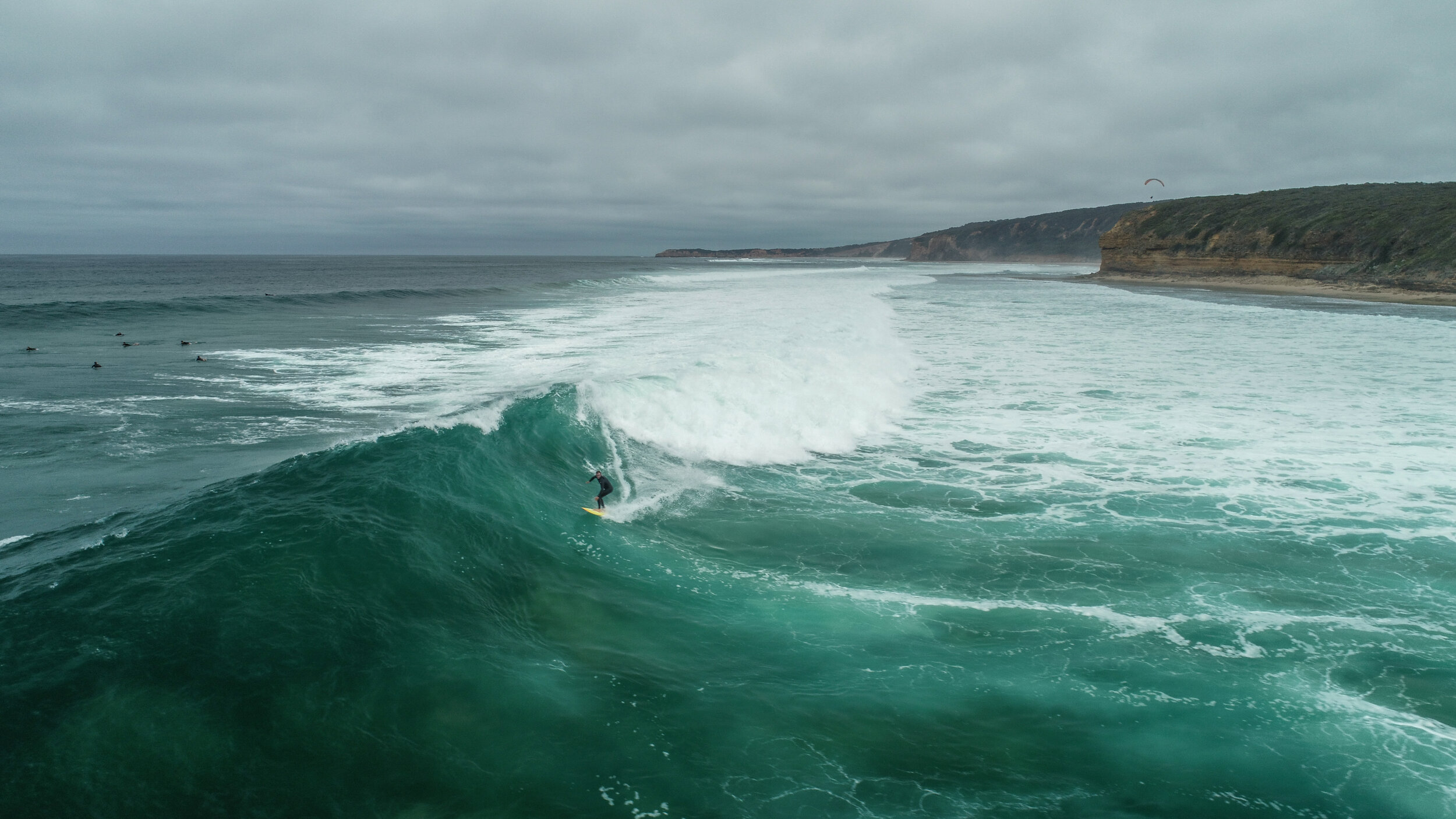
you may also like:





